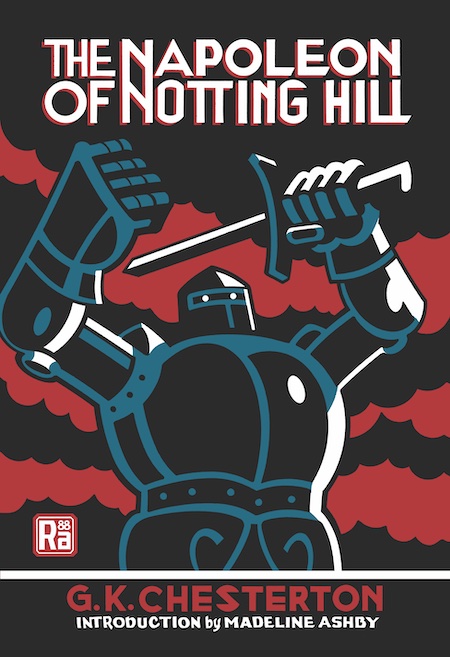THE NAPOLEON OF NOTTING HILL
By:
August 1, 2023
Under the direction of HILOBROW’s Josh Glenn, the MIT Press’s RADIUM AGE series is reissuing notable proto-sf stories from the underappreciated era between 1900–1935.
In these forgotten classics, sf readers will discover the origins of enduring tropes like robots (berserk or benevolent), tyrannical supermen, dystopias and apocalypses, sinister telepaths, and eco-catastrophes.
With new contributions by historians, science journalists, and sf authors, the Radium Age book series will recontextualize the breakthroughs and biases of these proto-sf pioneers, and chart the emergence of a burgeoning literary genre.
Today marks the publication of the following Radium Age series title…
G.K. CHESTERTON
Introduction by MADELINE ASHBY
(August 1, 2023)

When Auberon Quin, a prankster nostalgic for Merrie Olde England, becomes king of that country in 1984, he mandates that each of London’s neighborhoods become an independent state, complete with unique local costumes. Everyone goes along with the conceit until young Adam Wayne, a born military tactician, takes the game too seriously… and becomes the Napoleon of Notting Hill. War ensues throughout the city — fought with sword and halberd!
“A vastly entertaining book, which should be breathlessly enjoyed at Notting Hill and elsewhere.” — Daily Chronicle (1904)
“Whimsically expressed criticism… with a suspicion of gallimaufry and hints of the cap-and-bells here and there.” — New York Times (1904)
“As irresponsibly ludicrous as a modern burlesque, as quaintly serious, at last, as a medieval morality.” — The Bookman (May 1904)
“More modern than the moderns, more medieval than the medievalists, funnier than all of them — reading Chesterton today is like watching someone give a speech of unimpeachable common sense from the bridge of a departing UFO.” — Atlantic columnist James Parker
Press for MITP’s edition of The Napoleon of Notting Hill includes the following…
“Unquestionably a satirical masterpiece.” — Michael D. Gordin, Los Angeles Review of Books
MADELINE ASHBY is a consulting futurist and science fiction writer based in Toronto. She is the author of the Machine Dynasty series, Company Town, and contributor to How to Future: Leading and Sense-making in an Age of Hyperchange. She has developed science fiction prototypes for Changeist, the Institute for the Future, the Smithsonian Institution, SciFutures, Nesta, The World Health Organization, the World Bank, the Atlantic Council, and others. Her work has appeared in BoingBoing, Slate, MIT Technology Review, WIRED, and elsewhere.
G.K. CHESTERTON (1874–1936) was an English author, poet, critic, and newspaper columnist known for his brilliant, epigrammatic paradoxes. His best-known character is the priest-detective Father Brown, featured in over 50 stories published between 1910–1936, who solves mysteries and crimes thanks to his understanding of spiritual and philosophic truths; and his best-known novel is The Man Who Was Thursday (1908), a metaphysical thriller. In addition to The Napoleon of Notting Hill, his first novel, he wrote several other near-future satires of England.
Originally published in 1904. Cover designed by Seth. See this book at The MIT Press.
RADIUM AGE PROTO-SF FROM THE MIT PRESS: VOICES FROM THE RADIUM AGE, ed. Joshua Glenn | J.D. Beresford’s A WORLD OF WOMEN | E.V. Odle’s THE CLOCKWORK MAN | H.G Wells’s THE WORLD SET FREE | Pauline Hopkins’s OF ONE BLOOD | J.J. Connington’s NORDENHOLT’S MILLION | Rose Macaulay’s WHAT NOT | Cicely Hamilton’s THEODORE SAVAGE | Arthur Conan Doyle’s THE LOST WORLD & THE POISON BELT | G.K. Chesterton’s THE NAPOLEON OF NOTTING HILL | MORE VOICES FROM THE RADIUM AGE, ed. Joshua Glenn | William Hope Hodgson’s THE NIGHT LAND | Hemendrakumar Roy’s THE INHUMANS | Charlotte Haldane’s MAN’S WORLD | Francis Stevens’s THE HEADS OF CERBERUS & OTHER STORIES | Edward Shanks’s THE PEOPLE OF THE RUINS | J.D. Beresford’s THE HAMPDENSHIRE WONDER | John Taine’s THE GREATEST ADVENTURE | Marietta Shaginyan’s YANKEES IN PETROGRAD | BEFORE SUPERMAN: SUPERHUMANS OF THE RADIUM AGE, ed. Joshua Glenn | E. and H. Heron’s FLAXMAN LOW: OCCULT DETECTIVE | Irene Clyde’s BEATRICE THE SIXTEENTH | & more to come.
RADIUM AGE PROTO-SF: “Radium Age” is Josh Glenn’s name for the nascent sf genre’s c. 1900–1935 era, a period which saw the discovery of radioactivity, i.e., the revelation that matter itself is constantly in movement — a fitting metaphor for the first decades of the 20th century, during which old scientific, religious, political, and social certainties were shattered. More info here.
